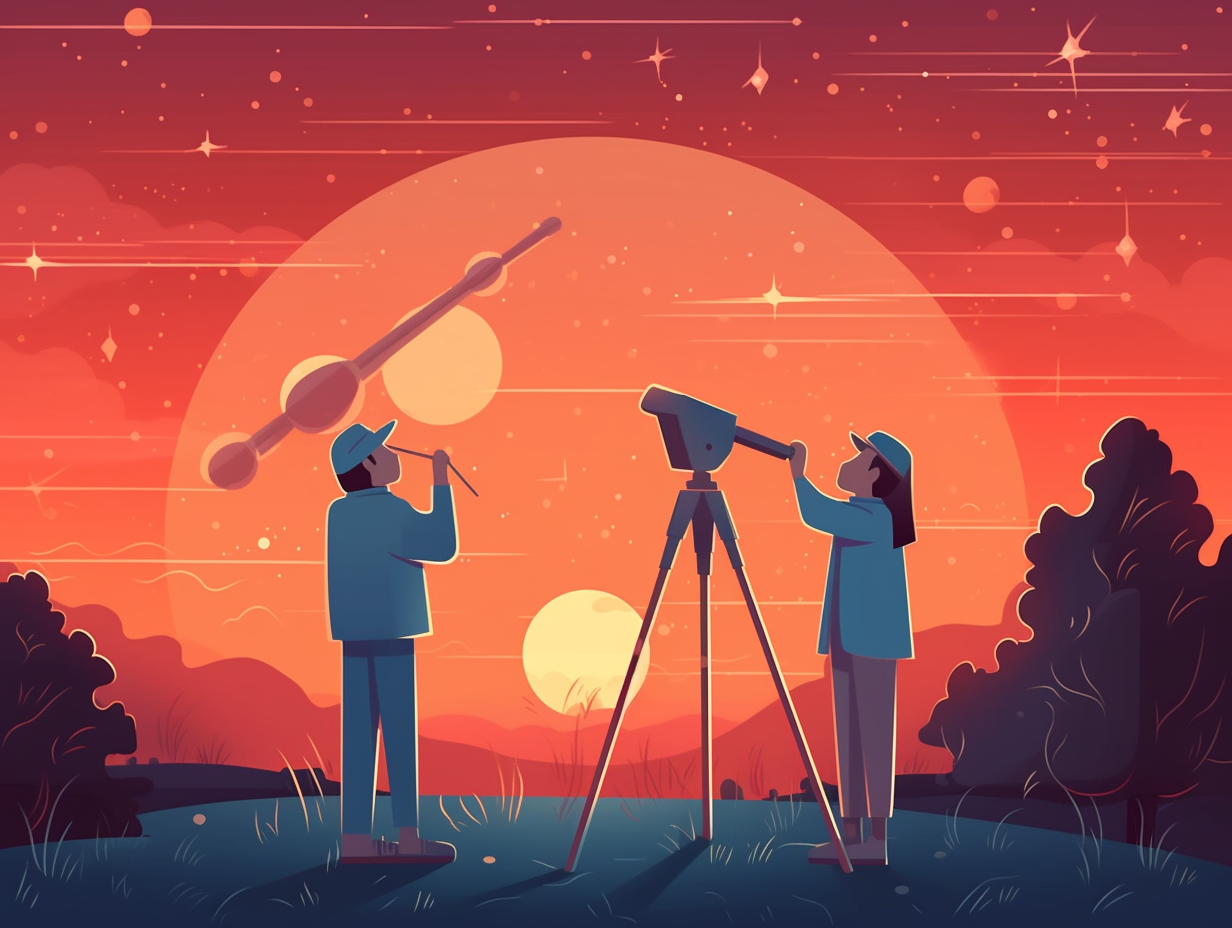13 Amazing Telescope Fun Facts That Will Astonish You and Expand Your Cosmic Knowledge!

1. Galileo's Moon-Dropping Discovery
Hold on to your lenses, Galileo's about to drop the moon on you: In 1610, when good ol' Galilei pointed his telescope skyward for the first time, he spotted Jupiter's four largest moons, essentially debunking the Earth-centric celestial belief and paving the way for a sun-centered solar system party.
Source => loc.gov
2. Hubble's Budget Shrinkage
Once upon a budget cut, NASA inadvertently crafted the cosmic version of 'Honey, I Shrunk the Kids': The Hubble Space Telescope originally sported the grand title of Large Space Telescope (LST) in 1970, destined to boast a 3-meter mirror diameter. Alas, penny-pinching led to the diminutive 2.4-meter doppelgänger we now admire, yet it gloriously overshadows its initial stature with astronomical discoveries and galactic glamour shots.
Source => en.wikipedia.org

Did you know the Hubble Telescope could spot ants building tiny sandcastles in your backyard from millions of miles away? Discover its incredible accuracy!
=> Fun Facts about The-Hubble-Telescope
3. Shakespearean Webb Telescope
Beam me up, Scotty, we've got space secrets to uncover! As the James Webb Space Telescope floateth in ye olde heavens, it peeketh into the unknown with an eager eye and giveth a celestial performance to rival even Shakespeare himself: Launched in 2021, this cosmic marvel boasts groundbreaking instruments like the Near-Infrared Camera (NIRCam) and the Mid-Infrared Instrument (MIRI), and has already gifted us our first direct glimpse of an exoplanet and unveiled new atmospheric revelations in the realm of alien worlds, despite the occasional hiccup in its otherwise stellar performance.
Source => space.com
4. Gran Telescopio Vacation Baby
Imagine if the Hubble Space Telescope and Iron Man had a baby, and that baby was named after a vacation destination: you'd get the Gran Telescopio Canarias! Seriously: This colossal, world-class telescope boasts a monstrous 10.4-meter diameter, cost €130 million, took seven years and over 1,000 people from 100 companies to construct, and comes loaded with gizmos like MEGARA and CanariCam for all your integral-field, multi-object, mid-infrared, spectroscopy, coronagraphic, and polarimetric needs.
Source => en.wikipedia.org

5. Aquaman's Neutrino Lab
Hidden beneath the waves like Aquaman's secret laboratory: ANTARES, a neutrino telescope, is anchored 2.5 km below the surface of the Mediterranean Sea off the coast of Toulon, France, detecting high-energy neutrinos in the Southern Hemisphere with its twelve vertical strings of photomultiplier tubes stretching 350 meters long!
Source => en.wikipedia.org
6. Hubble's Eagle Eye Limitations
You could say the Hubble Space Telescope has quite the eagle eye – or perhaps, an astrophotographer's dream – but don't expect it to help with your lost golf ball situation: The Hubble can distinguish objects the size of a golf ball from 12 miles away in space, yet it's not designed for Earthly snooping, as it focuses on capturing stunning images of distant galaxies and stars billions of light-years away.
Source => forbes.com
7. Laser Guide Star Sorcery
Feeling starstruck? Have no fear—astronomers have a trick up their sleeve to bring the stars a little closer: they create their very own! The Laser Guide Star technology uses powerful laser beams to summon artificial stars in the sky, aiding large telescopes in achieving pristine image clarity when observing celestial bodies.
Source => en.wikipedia.org
8. Newton's Kettle-Free Reflector
In a shiny act of "Mirror Mirror on the wall, who's the most reflective of them all?", Isaac Newton, the OG inventor of reflecting telescopes, successfully reflected on the nature of light without crafting the tool out of a kettle as rumored: The 1668 masterpiece utilized a curved mirror at the end of a tube, bouncing light to a smaller, angled mirror and allowing a crisp, magnified peek into the celestial affairs above.
Source => englishkettle.ru
9. Webb's Magnificent Mirror Dance
Mirror, mirror on the wall, who has the most impressive stargazing tool of them all? Why, it's the James Webb Space Telescope, of course: Boasting 18 hexagonal segments, each with seven tiny motors called actuators, this majestic space instrument adjusts its breathtaking reflector to bring you unparalleled glimpses of the infrared universe.
Source => science.org

10. Arecibo's Film Star Telescope
In a galaxy not so far away, where James Bond and extraterrestrial hunters once mingled: The Arecibo Observatory in Puerto Rico boasted the world's largest single-aperture telescope for 53 remarkable years before being dethroned in 2016. This colossal space peeper enjoyed a primary reflector diameter of 305 meters, expertly crafted from 38,778 aluminum panels suspended in a steel cable web, and sought to uncover the secrets of radio astronomy, atmospheric science, radar astronomy and ET whereabouts while moonlighting as a film and television star!
Source => en.wikipedia.org
11. Very Large Array's Cosmic "Y"
When life gives you "Y's," make interstellar discoveries: The Very Large Array's iconic "Y" shape isn't just for kicks and giggles, it actually enhances its ability to capture intricate details from the far reaches of space! Equipped with three arms, each housing nine telescopes, the VLA's configuration allows for optimal flexibility. And for an extra touch of cosmic coolness, a specialized rail truck called the Transporter helps shuffle the antennas along a vast track.
Source => public.nrao.edu
12. Atmosphere-Defying Thirty Meter Telescope
Ever looked through a telescope and thought, "Ugh, Earth's atmosphere, you're ruining my stargazing!"? Worry no more, my cosmic comrades: The Thirty Meter Telescope boasts adaptive optics that can clear up the atmospheric fuzz, allowing unrivaled clarity in the skyward sights it captures. As a bonus, it's not shy when it comes to data, gulping down a massive 90 terabytes each night thanks to its incredible light-gathering prowess.
Source => en.wikipedia.org
13. Giant Magellan, the Hubble Toppler
Step aside, Hubble; there's a new big kid on the block ready to steal your thunder, and his name is the Giant Magellan: This colossal cosmic peeper will feature seven ginormous mirror segments, each 8.4 meters in diameter, created by the University of Arizona's Richard F. Caris Mirror Lab. Not only will it boast a resolving power 10 times that of the Hubble Space Telescope, but it'll also leave the James Webb Space Telescope in the dust with four times its resolution capabilities!
Source => en.wikipedia.org
Related Fun Facts




















